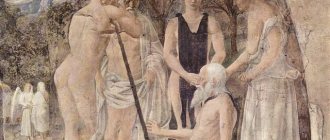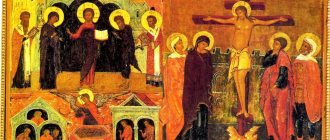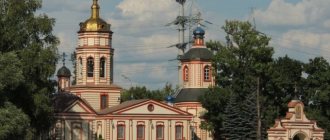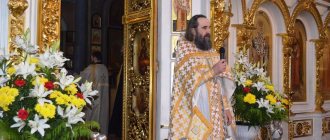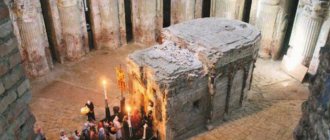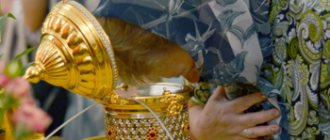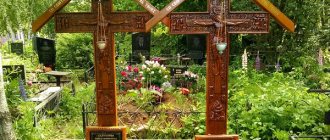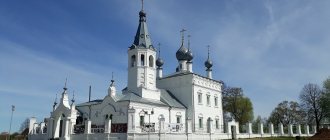Wood for the Cross of Christ
The history of the tree of the Cross began in biblical times, during the time of the forefather Abraham and the righteous Lot. According to the Old Testament, after the destruction of Sodom and Gomorrah, righteous Lot hid with his two daughters in a cave. His daughters decided that all humanity had been exterminated and there were no more men who would take them as wives. So they gave their father wine to drink and sinned with him. From their children subsequently came two nations - the Moabites and the Ammonites. Lot was in despair when he learned about what his daughters had done. Further history was not included in the Holy Scriptures, but was preserved in the Tradition of the Church.
Realizing his sin, he went to Abraham to repent. Abraham, as a sign of penance, gave Lot three staves, given to him by the Holy Trinity, when God in the form of three angels visited his monastery, and told him to plant these staves and water them with water, and when the tree gains life, this will become a sign of his forgiveness.
For about 40 years, Lot labored: he carried water from the Jordan on a donkey and watered these staffs (according to other versions, three seedlings or three burning logs). But the devil often tempted him, taking the form of a man, asking him to drink and drinking all the water, and Lot had to return to the Jordan again. And so three staves, three trees (cedar, cypress and pevg - pine) grew into one, into a single trunk with three divisions at the top - a triune tree - the image of the Holy Trinity. Lot realized that his sin was forgiven.
And the tree grew very beautiful. Later, when King Solomon was finishing the construction of the first temple, he needed a large tree to put on the roof of the holy temple, and Lot's tree was found suitable. They came and cut it down, but they were never able to attach it, because the tree was constantly changing in size - sometimes it seemed shorter, sometimes it grew larger. And, attributing it to Lot's sin, they decided that it was rejected by God, and threw it away. How can one not remember the words of the Gospel: “a stone, the builders did not use it - this became the cornerstone..”!
There is also a legend preserved in Western Christianity that after this, a beam made from this Tree was left as a bench in the temple courtyard (according to another version, it was used to make a bridge across the river). The Queen of Sheba, known for her wisdom, came to meet Solomon and sat down on this beam to rest. But she was burned by the fire coming from the Tree. After which, having bowed to the Tree, she predicted that the Savior of the world would be hanged on it, and therefore the kingdom of the Jews would come to ruin and end. Frightened, Solomon ordered the timber to be buried.
Subsequently, a bathhouse was built on this site for washing sacrificial animals. The water here became famous for healing, and numerous sick people began to visit it (according to various legends, it was either the Pool of Siloam or the Sheep Pool).
700 years later, shortly before the suffering of the Lord, the Tree emerged from the waters of the bath. When it was necessary to make a Cross for Jesus Christ, then they remembered about this rejected tree. Over so many centuries of being in the water, it became heavier than stone, which aggravated the suffering of the Savior, who then carried the Cross made from it and fell several times under its weight. In addition, the high priest Caiaphas decided that on this twisted tree Christ would suffer more intensely, and His crucifixion on this tree would humiliate Him even more.
We find prophecies that Christ will be crucified on a three-part tree, and indications that these three types of wood are sacred, in the books of the Old Testament. The prophet Isaiah predicted: “The glory of Lebanon will come to you, cypress and tree and cedar together, to adorn the place of My sanctuary, and I will glorify My footstool” (Is. 60:13). In Orthodox worship, this prophecy refers to the Honest Tree of the Cross of Christ. Liturgical texts call the Cross of Christ a cypress, a song and a cedar: “Like mercy is a cypress, like a fragrant cedar is faith, like a song that brings true love, let us worship the Lord’s Cross, glorifying the Savior nailed on it.”
The “three-part structure” of the Cross among the Old Believers means that the Cross must necessarily be depicted as eight-pointed.
The Old Testament mentions cedar and cypress among the trees of paradise. To decorate the Jerusalem Temple, which represented the image of paradise, cedar, cypress and pevg (fir) were used. In preparation for the construction of the House of the Lord, Solomon asked Hiram, king of Tyre, to send him cedar trees, cypress and pine trees from Lebanon.
In Old Testament services, only certain types of trees that had a scent were used for sacrificial firewood so that their fragrance would rise to the sky, namely: cypress, spruce, almond, pine, fir, cedar, juniper, lemon, olive, myrtle, laurel, cedar and balsam bush. According to Old Testament tradition, as Abraham prepared to sacrifice his son, he took the wood for the burnt offering and placed it on Isaac, just as a cross is placed on the shoulders of a person being led to crucifixion. According to the Church Fathers, the firewood here symbolizes the Cross of Christ. According to Origen, Isaac represented Christ both as a sacrifice and as a priest, for in the Old Testament only priests had the right to bring firewood for sacrifices.
In the Byzantine era, in the vicinity of Jerusalem, a monastery was founded on the site where, according to legend, the Tree of the Cross grew. According to one version, the monastery was built by Queen Elena herself. Then Emperor Constantine presented it to the Georgian king Mirian (265-342), who was converted to Christianity by St. Nina, the enlightener of Georgia, on whose advice Mirian went to Jerusalem as a pilgrim and in his old age (in 316) settled in the Holy Land. Another version attributes the construction of the monastery on the site acquired by King Mirian to another great Georgian king - Vakhtang I Gorg-Asalom (446-499), who built many monasteries in Jerusalem. One way or another, for hundreds of years the monastery was in the hands of Georgians and served as a monastery for pilgrims to the Holy Land from the Caucasus.
The heyday of the monastery occurred at the time when Queen Tamara bought from Tsalakh ed-Din all the Georgian shrines captured by the Muslims during the invasion of Jerusalem and she financed their restoration through her treasurer Shota Rustaveli. In 1185, Shota Rustaveli arrived at the monastery and carried out repairs to the buildings. It was in the Monastery of the Cross that he painted “The Knight in the Tiger’s Skin”, where there is his only self-portrait (Rustaveli was also an icon painter) - he depicted himself as a small figure bowing before two saints. Rustaveli died in this monastery and, according to legend, was buried there, right behind the altar. Over time, Georgia weakened as a power and the monastery was bought by the Orthodox Greeks. Since then, the monastery has belonged to the Greek Orthodox Church, although to this day the frescoes on the walls are signed in ancient Georgian, and the monastery itself is located on the street. Shota Rustaveli.
To this day, the place where the tree of the Cross grew remains behind the main altar and is marked with a silver circle. Any pilgrim staying in the Holy Land can visit it.
Svetlana Finogenova
Where to see the relics
A number of Christian shrines relating to biblical events associated with the last days of the life of JESUS CHRIST are especially revered. They are scattered all over the world, the authenticity of some of the items is disputed, and some are presented in several variations.
- THE CROSS on which Jesus . Large fragments are kept in St. Peter's Basilica in Rome (Vatican), in Notre Dame de Paris, in the monastery in Cetinje (Montenegro), in the Cathedral of Santa Maria del Fiore (Florence), in the Museum of the Imperial Residence Hovburg (Vienna) ).
- NAILS with which Jesus was nailed to the cross. It is still unclear how many nails there were. Artifacts are presented in the Basilica of the Holy Cross of Jerusalem (Rome), in the Cathedral of St. Peter (Trier, Italy), in the Cathedral of the Nativity of the Virgin Mary (Milan), in the Kunsthistorisches Museum in Vienna, in Notre Dame de Paris, in the Duomo Cathedral di Monza (Milan), in the Cathedral of Christ the Savior (Moscow).
- TITLO - a tablet with the inscription "Jesus of Nazareth, King of the Jews" - in the Basilica of the Holy Cross of Jerusalem in Rome.
You can see a plaque with the inscription “INRI” in Rome
- The SPEAR with which the Roman warrior Longinus pierced the chest of the crucified Christ is kept in the Etchmiadzin Temple (Yerevan, Armenia).
- VERONICA'S VEIL (Veil of Veronica) is a miraculous image of the Savior that appeared on the scarf that Saint Veronica gave to Jesus Christ when he carried the cross to Calvary. Kept in St. Peter's Basilica in Rome.
- THE CROWN OF THORNS is located in the Cathedral of Notre Dame de Paris.
- CROWN OF THORNS THORKS (about 70): in the Basilica of the Holy Cross in Rome, in the Church of St. John the Baptist in Venice, in the Kunsthistorisches Museum in Vienna, in the Basilica of St. Nicholas in Bari (Italy), in the treasury of the Cathedral of St. Lawrence (San -Lorenzo) in Italian Genoa.
- Turin Shroud - kept in the Cathedral of St. John the Baptist in Turin, Italy.
Cathedral of John the Baptist in Turin, where the famous shroud is kept
- HOLY BLOOD OF CHRIST - you can venerate the vessel with the relic in the Basilica of the Holy Blood in Bruges (Belgium).
Buy a wooden wall cross Crucifixion
The selection of wall crosses in church shops, as a rule, is not very diverse, both in price and in appearance of the product. For those who want to purchase a truly exclusive product, choosing it from many others, and without spending a lot of time on the choice, the best solution is to buy a wall-mounted Orthodox cross in the PravLife online store.
We work with a large number of reliable suppliers, from the most famous Orthodox workshops. A large number of monastery and church craftsmen help us maintain a huge selection of Orthodox-themed products on the site. All products are of impeccable quality and created with love.
Good afternoon Dear friends, let me describe in more detail the presented work, The Crucifixion of Jesus Christ. The figure of Christ is made of linden, the cross is made of pine. The work was commissioned by a private individual in Kazan in 1998, but upon completion of work on the image, contact with the customer was lost and the work remained the property of the author. The crucifixion is not canonical from the point of view of Orthodoxy, although the cross is eight-pointed, the figure itself is completely separated from the cross (Orthodoxy is not very loyal to round sculpture), there is a crown of thorns on the head of Jesus, and the halo is missing, the feet are parallel and pierced with two nails, as depicted in Orthodoxy, although in early Catholic Crucifixions such an image was also present, in later ones the feet of Christ’s feet are superimposed on one another and pierced with one nail, which opened up a new iconographic motif for a more voluminous modeling of the body. So the Crucifixion is rather Catholic. The image of Christ is little dramatized, he does not die on the cross with his head bowed on his shoulder, the head of Christ is raised high and proudly, the body does not sag on the cross, but seems to float on it, as if devoid of heaviness. Christ looks more like a winner than a dying sufferer, he wears a crown of thorns more like a crown, the opening wound on his side is just an attribute of iconography. The position of the hands stretched along the cross is calm, without tension. The sacrificial image of Christ conquers death. Why am I describing this work in detail? Because the description of this visual work was, as it were, the technical specification of the customer, and that is how it appears, I think, before the viewer. According to the execution technique: the central part of the figure is made from a solid trunk, the arms are extended. Articulation of the hands on the forearm at a distance of 2/3 from the shoulder, closer to the elbow. The joint is reinforced inside with a rod made of hard wood (apple tree). The wood grains of the arms are parallel to the wood grains of the body. This made it possible to evenly tint the entire surface, without sharp color transitions on the body and arms of the figure. The crown of thorns on the head is made of a monolith of wood and only those spikes of the wreath that are directed perpendicular to the direction of the fibers of the material are inserted. Presented work in 2006 was the model for the creation of the Crucifixion in the St. Nicholas Monastery in Saratov. The dimensions of the figure of Christ were 160 cm, and the cross - 240 cm. Thank you! Best wishes!
